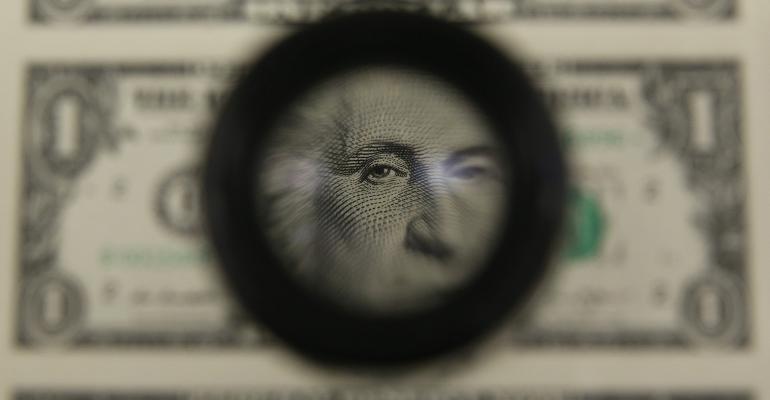(Bloomberg Opinion) -- The rate on some US Treasury bills, considered the safest investment in the world and just as good as cash, rose above 5% this week, a level not seen since early 2007. The question investors should be asking is, why only 5%?
To find the answer, let’s start by comparing short-term Treasury rates to yields implied by effective federal fund futures. Loosely speaking, the effective fed funds rate is what the futures market projects the Federal Reserve’s target rate will be in the future. The blue line suggests the Fed will raise its target for the fed funds rate 0.50% to 0.75% by September 2023, followed by a gradual lowering of rates. The orange line plots current rates on various Treasury maturities; It seems to suggest the smaller rate hikes ending earlier.
So, the Treasury market is pricing in a more dovish Fed than the futures market. Futures traders also seem to expect a rapid deceleration of inflation. The inflation rate as measured by the consumer price index rose 6.4% in January from a year earlier and hasn’t been below 5% since February 2021. For an investor who buys a one-year Treasury bill not to lose purchasing power, she would need a rapid and dramatic slowdown in inflation, something that seems inconsistent with the data and other indicators.
Consider the difference between two- and 10-year Treasury note yields. That spread stands at negative 0.89%, the most since September 1981. That, again, suggests bond investors expect a major decline in long-term yields, greater than any seen in the last 30 years. Moreover, while 10-year yields did rapidly drop after hitting 15.80% in September 1981, it’s hard to imagine something similar from the current level of 3.85%.
Another long-term indicator is break-even rates on Treasuries, which are taken as a measure of what traders expect the rate of inflation to be over the life of the securities. For 10-year notes, that rate is 2.31%. It seems optimistic to expect that to be the average rate of inflation over the next decade, especially without further aggressive actions by the Fed and a recession.
We’ve looked only at technical measures so far. But shouldn’t Treasury yields be higher simply due to concern about a dysfunctional political climate, including the possibility of default? Or the high level of US debt along with long-term fiscal issues such as Social Security and Medicare? Or all the other political, military, public health, diplomatic and environmental risks? In the short run, investors usually flock to Treasuries in a crisis, but their long-term value depends on a Congress willing and able to service the debt and, in cooperation with the Fed, to maintain the value of the dollar.
The 20 years from 1986 to 2006 were designated the “ Great Moderation.” It seemed that rapid economic growth was possible with central bankers keeping inflation firmly under control without actions that might cause deep or long-lasting recessions. The subsequent financial crisis in which central banks seemed to have little power smashed that idea, as did following events such as the European sovereign debt crisis. The one evil the world was spared from 2006 to 2021 was inflation, but that reappeared in 2022 and central banks have not proven they can control it, much less control it without triggering long and deep recessions.
But the Treasury market today seems more attuned to Great Moderation assumptions than the sadder-but-wiser views of investors who survived the past 17 years. Accepting a rate of 5% for lending money to the US government for up to one year when both inflation and effective fed funds rates seem likely to be higher than 5%, and maybe much higher, seems like a poor bet. And locking in 3.85% for 10 years seems to have a lot more downside than upside.
The alternative of investing in stocks carries its own risks, as equities have much higher volatility than bonds, but at least the volatility seems two-sided —you might lose but you also might win. Treasuries seem priced to give a fair return after inflation in the best of all possible worlds, and a mediocre or terrible one in others. Investors should not be asking, “Why did T-bill rates go over 5%?” but, “How is it remotely reasonable that the T-bill rates are only 5%?”
More From Bloomberg Opinion:
- Inflation Boogeyman Now Hides in Services: John Authers
- This CPI Report Will Lead to Bad Fed Decisions: Karl W. Smith
- Will the Fed Go Longer or Higher? Maybe Both: Bill Dudley
Want more Bloomberg Opinion? OPIN <GO>. Or you can subscribe to our daily newsletter.




